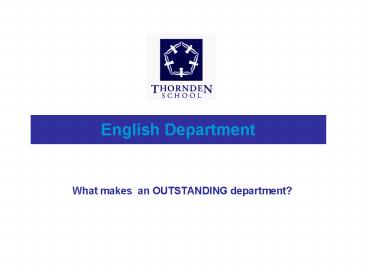English Department - PowerPoint PPT Presentation
1 / 11
Title:
English Department
Description:
Department Inset / Professional development. Standardisation of exam ... Inset delivered on how to teach / mark the GCSE skills. Resources produced and shared ... – PowerPoint PPT presentation
Number of Views:22
Avg rating:3.0/5.0
Title: English Department
1
English Department
- What makes an OUTSTANDING department?
2
Headlines 2008
- GCSE English 2008 94 A-C
- GCSE English Literature 2008 98 A-C
- 116 pupils (42 of pupils) achieved A-A
- 54 boys (36 of boys) achieved A-A
- 62 girls (50 of girls) achieved A-A
- 221 pupils (80.1) achieved their predicted grade
or higher
3
Preparing for KS4 in KS3
- Teachers follow Department Curriculum Map in
Y7,8,9 - Common Schemes of Work and Assessments
- SATs moved to Year 8
- Year 9 Enrichment Programme
- Schemes of work matched to KS4 / AQA objectives
- Year 9 Booster Set differentiated materials
pace - Max 20 pupils identified
- Create 2 groups of 10 pupils with LSA support
4
Criteria used for KS4 groups
- Verbal CAT - scrutinised in relation to Mean CAT
- Teacher Assessment in Year 9
- Pupil behaviour
- Pupil needs
- Pupil / Teacher relationships
- Balance of pupils male and female
- Result of task completed under controlled
conditions
5
Putting the groups together
- Extension groups
- 60 pupil identified
- 2 classes of 30
- Mixed Ability groups
- Class sizes average of 20-23 pupils
- 10 classes
- Responsibility HOD / 2ic advised by HOY and
SENCO
6
Matching teacher to groups
- Considerations
- Workload
- Max of 3 KS4 classes for experienced teacher
- NQT or NQT 1 max of 2 KS4 classes
- HOD 4 KS4 classes to enable pupil movement
7
Common approach to KS4
- All pupils entered for English and English
Literature - Pupils withdrawn from Lit if English C grade
under threat - Fixed plan for Year 10 and 11
- Coursework completed in Year 10 / Paper 1 Eng /
Lit Exam text - Exam preparation in Year 11 / opportunity to
revisit coursework - Shared resources
- Posted on the VLE
- NQTs follow prescribed Schemes of Work
8
Understanding GCSE syllabus
- Planning and teaching the syllabus as a series of
skills - Department Inset / Professional development
- Standardisation of exam and coursework pieces
- An AQA GCSE Senior Examiner in the department
- Feedback to the dept. on the mechanics of the
exam papers - Inset delivered on how to teach / mark the GCSE
skills - Resources produced and shared
9
Approach to Revision
- Revision Pack for all Year 11 pupils
- Distributed early and used as a teaching tool
- All key elements of the exams covered in one
document - Targeted Revision classes
- 6 focused sessions
- 20 key C / D borderline pupils identified and
formally invited - 25 30 A / A pupils nominated from mixed
ability groups
10
How is success achieved?
- Learning teaching styles
- Follow whole school Learning Teaching
Guidelines - High expectations from pupils and teachers / Year
11 is priority - Learn from successes failures at KS3
- Curriculum structure
- KS3 shortening
- Common Curriculum Maps at KS3 KS4
- Year 9 Enrichment follows GCSE syllabus
objectives - GCSEs in Year 10 ( x 5 periods) Year 11 (x 6
periods)
11
How is success achieved?
- Intervention Strategies
- HOD with 4 KS4 classes to give flexibility
- Common SOWs for NQTs available to whole
department - Planning and sharing information with HOY and
SENCO - Department Management Structure
- HOD responsible for department KS4 / NQTs KS4
- 2ic responsible for KS3 / NQTs KS3
- Leading Edge position new to 2008
- TLR Reading position at KS3 - new to 2008
- TLR Performance position at KS3 - new to 2008































